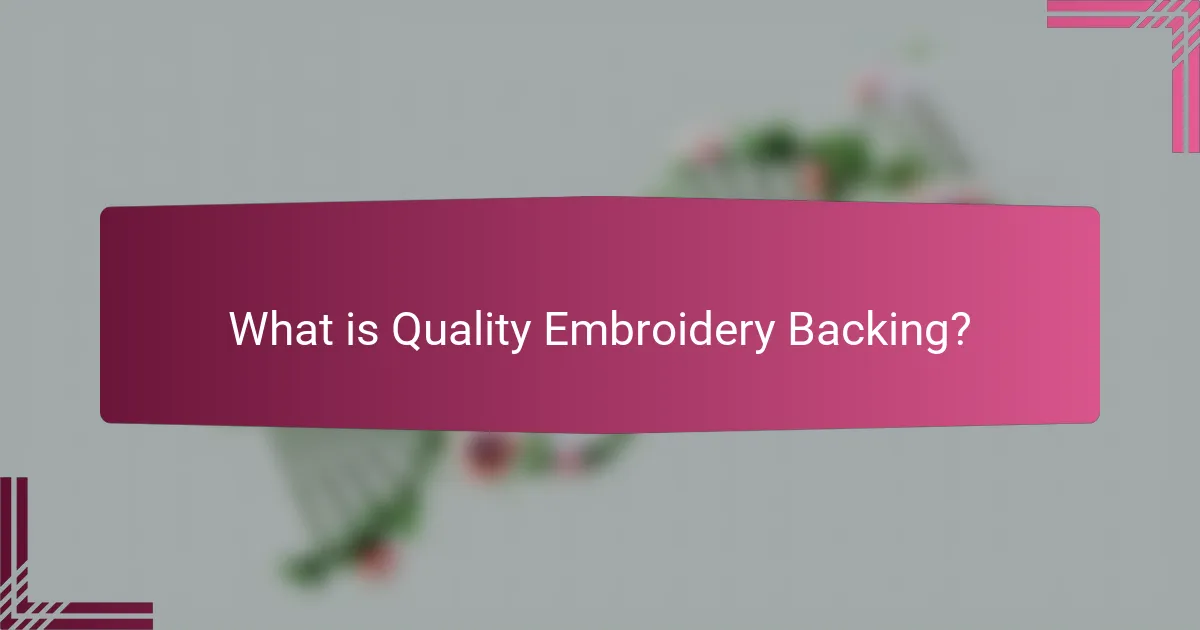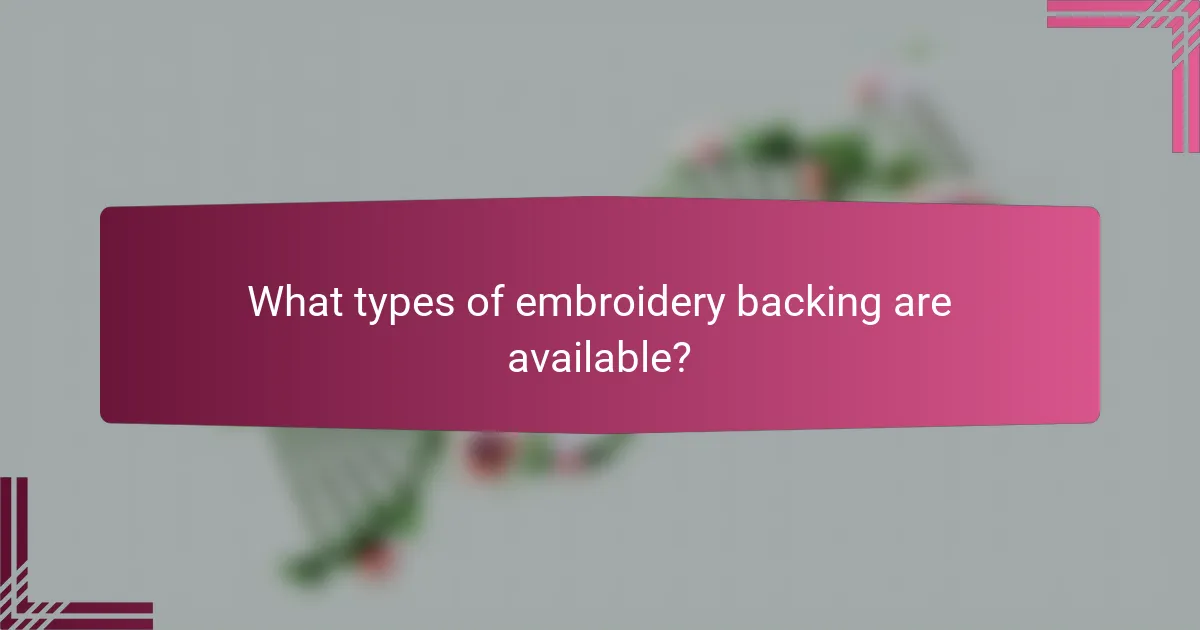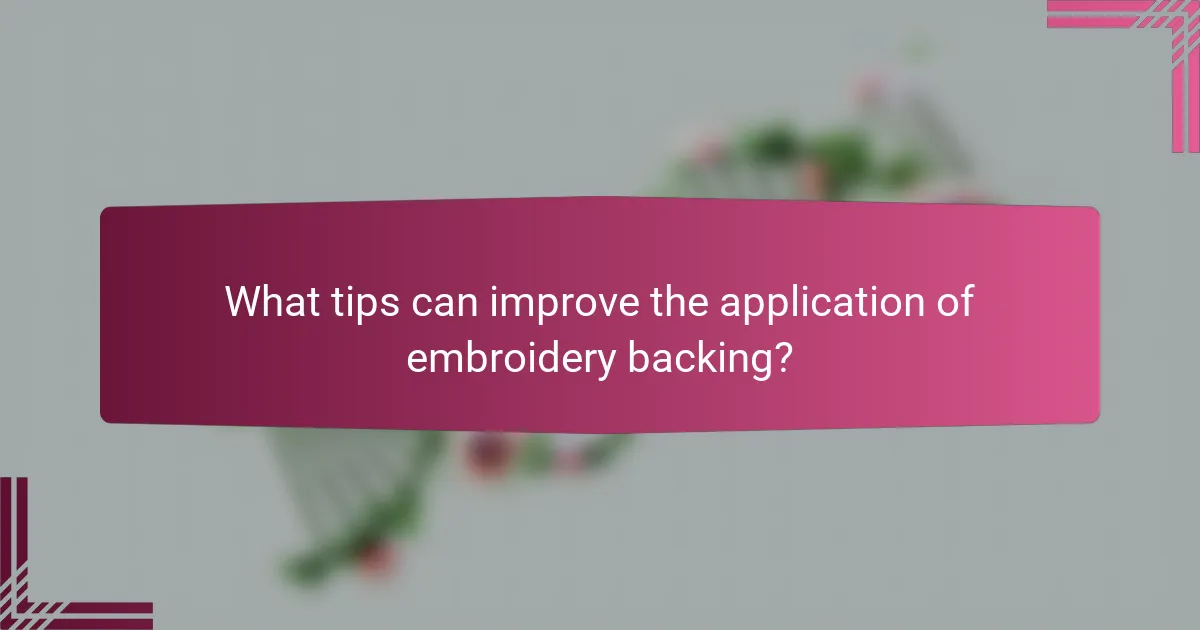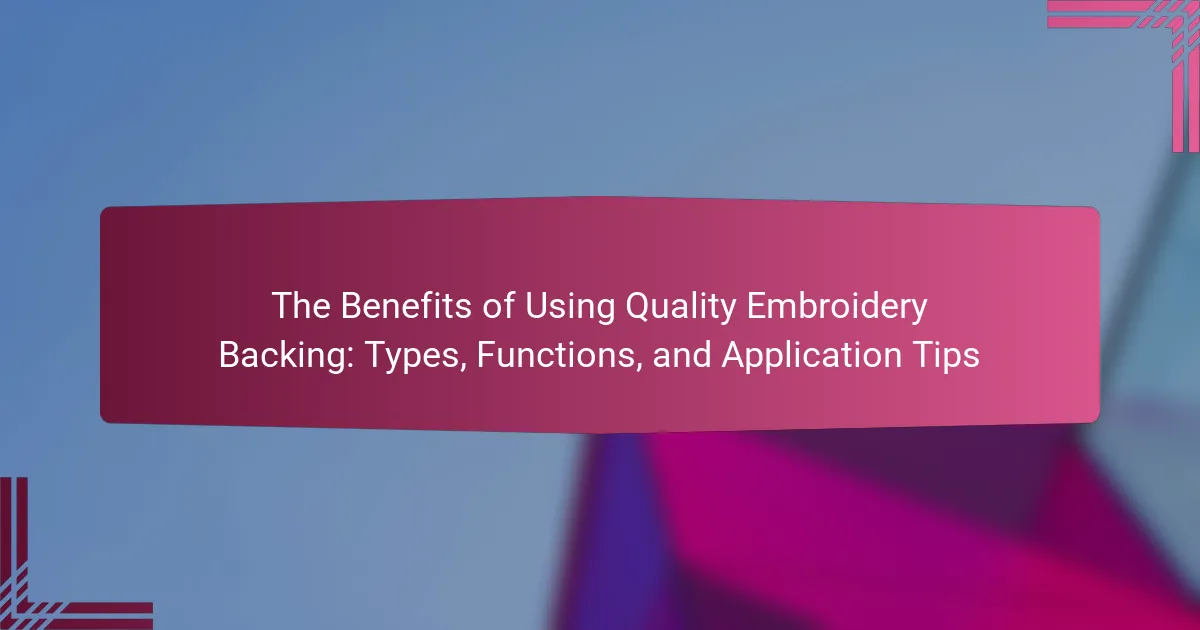
What is Quality Embroidery Backing?
Quality embroidery backing is a supportive material used during the embroidery process. It stabilizes the fabric and prevents distortion. Backing comes in various types, such as tear-away, cut-away, and water-soluble. Each type serves specific purposes based on the fabric and embroidery design. Quality backing enhances the overall appearance of the finished embroidery. It also prolongs the life of the embroidered piece by reducing wear. Proper selection of backing is essential for achieving professional results. Studies show that using quality backing can improve stitch definition and reduce thread breakage.
How does Quality Embroidery Backing contribute to the embroidery process?
Quality embroidery backing stabilizes fabric during the embroidery process. It prevents distortion and puckering of the fabric. This stability allows for precise stitching and clean designs. Quality backing also supports the needle and thread, ensuring consistent tension. It enhances the overall durability of the finished embroidery. Different types of backing are used for various fabrics, optimizing results. For example, tear-away backing is ideal for lightweight fabrics. Research shows that using quality backing can significantly improve the longevity of embroidered items.
What are the different types of embroidery backing materials?
The different types of embroidery backing materials include cut-away, tear-away, water-soluble, and adhesive backings. Cut-away backing provides stability and is ideal for dense designs. Tear-away backing is easy to remove and suitable for lighter fabrics. Water-soluble backing dissolves in water, making it perfect for delicate embroidery. Adhesive backing allows for easy placement of fabric and is useful for intricate designs. Each type serves specific functions in embroidery projects. For instance, cut-away backing prevents distortion during washing, while tear-away backing offers convenience for quick projects.
How do various backing materials impact the final embroidery result?
Various backing materials significantly impact the final embroidery result. Different types of backing provide varying levels of support and stabilization. For instance, cutaway backing offers strong support for dense designs, preventing distortion. Tearaway backing allows for easy removal and is suitable for lighter designs. Water-soluble backing creates a clean finish on delicate fabrics. Each backing material affects stitch definition, fabric tension, and overall durability. The choice of backing can enhance or detract from the embroidery’s appearance. Quality backing materials lead to professional-looking results and minimize issues like puckering or thread breakage.
What are the primary benefits of using quality embroidery backing?
Quality embroidery backing provides stability and support to the fabric during the embroidery process. It prevents distortion of the fabric and ensures that stitches are consistent and even. This backing enhances the overall appearance of the finished design. It also protects the fabric from needle damage and reduces puckering around the embroidery. Quality backing can improve the durability of the embroidery, ensuring it withstands washing and wear. Different types of backing are available, such as tear-away and cut-away, each serving specific purposes. Using the appropriate backing type can significantly impact the quality of the final product.
How does quality backing enhance the durability of embroidered designs?
Quality backing enhances the durability of embroidered designs by providing stability and support. It prevents the fabric from puckering or distorting during the embroidery process. This stability allows for cleaner stitching and reduces the risk of thread breakage. Quality backing also protects the underlying fabric from damage. It minimizes wear and tear, prolonging the life of the embroidery. For instance, using a tear-away backing can help maintain the design’s integrity after the embroidery is complete. Studies show that proper backing can increase the lifespan of embroidered items by up to 50%.
In what ways does quality backing improve the appearance of embroidery?
Quality backing enhances the appearance of embroidery by providing stability and support. It prevents distortion during the stitching process. This stability ensures that the design maintains its intended shape. Quality backing also improves the overall texture of the fabric. A smoother backing allows for cleaner stitches and more defined details. It can help prevent puckering around the embroidery. Additionally, quality backing can enhance the color vibrancy of the threads. This results in a more polished and professional look.

What types of embroidery backing are available?
There are several types of embroidery backing available. The main categories include cut-away, tear-away, wash-away, and fusible backings. Cut-away backing provides stability and is ideal for dense designs. Tear-away backing is easy to remove and works well for light designs. Wash-away backing dissolves in water, making it suitable for delicate fabrics. Fusible backing has an adhesive side to bond with fabric, offering extra support. Each type serves a specific purpose in embroidery projects.
What are the main categories of embroidery backing?
The main categories of embroidery backing are cut-away, tear-away, and water-soluble. Cut-away backing provides stability and is ideal for dense designs. Tear-away backing is easy to remove and suits lighter fabrics. Water-soluble backing dissolves in water, making it suitable for delicate projects. Each type serves a specific purpose based on the fabric and design requirements.
What is the difference between cut-away and tear-away backing?
Cut-away backing is a type of stabilizer that remains on the fabric after embroidery. It provides support for dense designs and is ideal for knit fabrics. Tear-away backing, on the other hand, is designed to be removed easily after stitching. It is suitable for lightweight fabrics and simpler designs. Cut-away backing offers more stability and is less likely to distort the embroidery. Tear-away backing allows for quicker removal and less bulk. Each type serves different purposes based on fabric and design complexity.
When should you use water-soluble backing?
Water-soluble backing should be used when embroidering on delicate fabrics. It provides support without damaging the material. This type of backing dissolves in water, leaving no residue. It is ideal for intricate designs that require precise detailing. Using water-soluble backing helps prevent fabric distortion during the embroidery process. It is also beneficial for projects where the backing needs to be removed completely. Common applications include lace, tulle, and other sheer fabrics. The use of water-soluble backing enhances the final appearance of the embroidery.
How do different types of backing serve specific functions?
Different types of backing serve specific functions by providing support, stability, and protection to embroidered designs. Cut-away backing offers strong support, making it ideal for dense designs. Tear-away backing allows for easy removal after stitching, suitable for lightweight fabrics. Water-soluble backing dissolves in water, perfect for delicate or sheer materials. Adhesive backing provides a temporary hold, allowing for repositioning during the embroidery process. Each type is tailored to specific fabric types and design complexities. Using the correct backing enhances the quality and durability of the final embroidery.
What role does adhesive backing play in embroidery projects?
Adhesive backing provides stability and support during embroidery projects. It secures the fabric in place, preventing movement while stitching. This backing is especially useful for delicate or stretchy materials. It enhances the overall quality of the embroidery by ensuring precise stitching. Adhesive backing can also simplify the process of hooping the fabric. It allows for easier alignment and positioning of the design. Many professionals recommend using adhesive backing for intricate designs. This practice leads to cleaner, more professional-looking results.
How does stabilizer backing affect the stitching process?
Stabilizer backing significantly affects the stitching process by providing support and stability to the fabric. It prevents fabric distortion during embroidery, ensuring that stitches remain even and aligned. Stabilizer backing also helps to absorb the tension of the stitching, which reduces puckering. Different types of stabilizers, such as tear-away or cut-away, offer varying levels of support based on the fabric and design complexity. For instance, tear-away stabilizers are ideal for lightweight fabrics, while cut-away stabilizers are better for heavier fabrics. This selection impacts the final appearance and durability of the embroidered design. Proper use of stabilizer backing can enhance the quality of the stitching and the longevity of the embroidery.

What tips can improve the application of embroidery backing?
Choose the right type of embroidery backing for your fabric. Different fabrics require specific backings for optimal results. Use a tear-away backing for simple designs and a cut-away backing for more intricate patterns. Ensure the backing is larger than the design area to prevent fraying. Pre-wash the fabric to eliminate shrinkage issues. Use a temporary adhesive spray to hold the backing in place during stitching. Adjust the tension settings on your embroidery machine to accommodate the backing thickness. Finally, test on a scrap piece before starting the final project to ensure compatibility.
How should you choose the right backing for your project?
To choose the right backing for your project, consider the fabric type and project requirements. Different fabrics require specific backing to ensure stability and quality. For lightweight fabrics, use a lightweight backing to prevent distortion. Heavier fabrics may need a sturdier backing for support.
Evaluate the embroidery technique as well. Certain techniques, like free-standing lace, require specialized backing. Assess the desired finish as well; some projects may benefit from tear-away backing for easy removal.
Finally, consider the project’s longevity. Washable projects may need a more durable backing. Research shows that using the appropriate backing can enhance the overall quality of the embroidery work.
What factors should you consider when selecting embroidery backing?
When selecting embroidery backing, consider the type of fabric being used. Different fabrics require specific backing types for optimal results. The weight of the backing is also crucial; lighter fabrics need lighter backings and vice versa. Stability is another important factor; some projects require more support than others. Adhesive properties can affect how well the backing adheres to the fabric during stitching. Additionally, consider the washability of the backing, especially for items that will be laundered. Lastly, the intended use of the embroidered item can influence the choice of backing, such as durability for wearables versus softness for decorative items.
How can you properly apply and secure embroidery backing?
To properly apply and secure embroidery backing, start by selecting the appropriate type of backing for your fabric. Cut the backing to the size of the design or slightly larger. Place the backing underneath the fabric, ensuring it is smooth and wrinkle-free. Use temporary adhesive spray or pins to hold the backing in place if needed. Adjust the fabric and backing together in the embroidery hoop, ensuring they are taut but not stretched. Secure the fabric and backing by tightening the hoop screws. This method prevents shifting during the embroidery process. Proper application ensures clean and precise stitching, enhancing the overall quality of the embroidery.
What common mistakes should be avoided when using embroidery backing?
Using the wrong type of embroidery backing is a common mistake. Each fabric requires a specific backing type for optimal results. Not pre-washing the fabric can lead to shrinkage issues later. Failing to stabilize the fabric can cause distortion during the embroidery process. Additionally, using insufficient backing thickness can result in poor stitch quality. Ignoring the manufacturer’s guidelines for backing can compromise the final product. Lastly, neglecting to test the backing on a sample piece can lead to unexpected outcomes. These mistakes can significantly affect the quality and durability of the embroidery work.
How can improper backing choice affect the embroidery outcome?
Improper backing choice can lead to poor embroidery outcomes. It may cause fabric distortion during stitching. This distortion affects the design’s alignment and overall appearance. Additionally, inadequate backing can lead to thread breakage. Thread breakage interrupts the stitching process and increases production time. Weak backing may also result in inadequate support for intricate designs. This can lead to puckering or uneven stitches. Ultimately, choosing the wrong backing compromises the quality and durability of the finished embroidery.
What troubleshooting tips can help with backing issues during embroidery?
Ensure the backing is appropriate for the fabric type. Use a heavier backing for thicker fabrics. Check for proper tension settings on the embroidery machine. Adjust the needle type based on the backing thickness. Verify that the backing is securely hooped to prevent movement. Use temporary adhesive spray to hold the backing in place. Test stitch on a scrap piece to identify issues before the final project. Monitor for puckering and adjust the design or backing as needed.
Quality embroidery backing is a crucial material that provides support and stability during the embroidery process, preventing fabric distortion and enhancing the overall appearance of the finished design. This article covers the various types of embroidery backing, including cut-away, tear-away, water-soluble, and adhesive options, each serving specific functions based on fabric type and design complexity. It also discusses the benefits of using quality backing, such as improved stitch definition, durability, and longevity of embroidered items. Additionally, practical tips for selecting and applying the appropriate backing are provided, highlighting common mistakes to avoid and troubleshooting strategies for successful embroidery outcomes.
